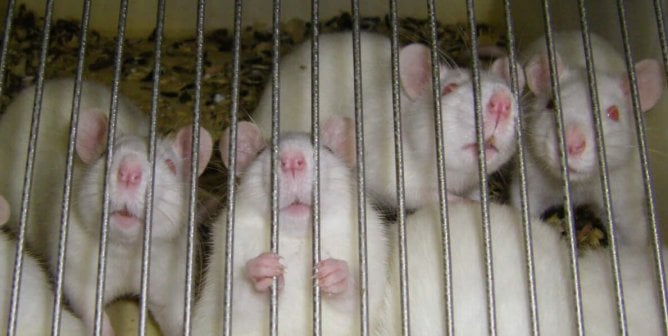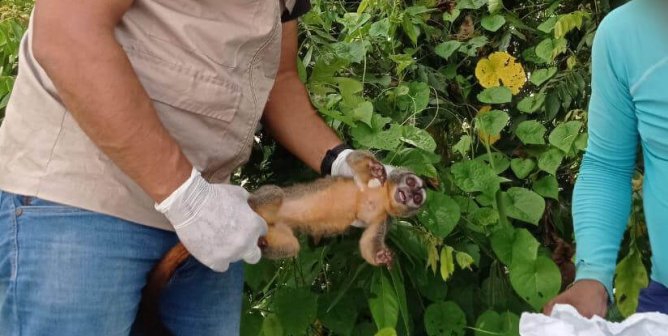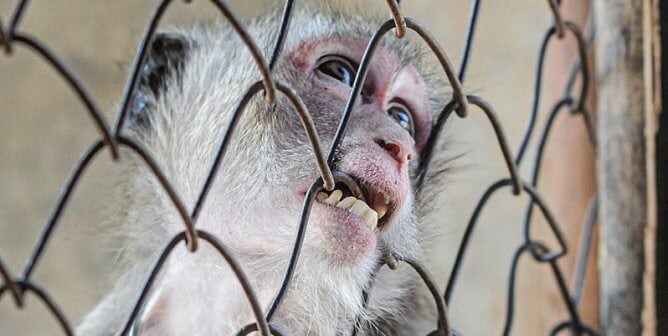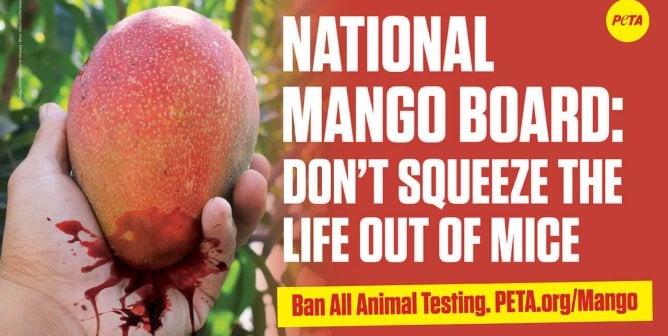Old Dominion University Is a Taxpayer-Funded Hellhole for Animals
What happens to animals in taxpayer-funded experiments at Old Dominion University (ODU)? Discover what lies behind the school’s closed doors.
- Official Animal Welfare Concerns
- Number of Animals Used
- Examples of Experiments Involving Animals
- Media Reports
- Public Funding
Official Animal Welfare Concerns at ODU
ODU uses many animals, including guinea pigs, rabbits, pigs, and mice, in experiments annually. Federal oversight agencies responsible for ensuring compliance with animal welfare standards have documented numerous violations at the university.
ODU doesn’t have a statement posted on its website regarding a commitment to the principles of the “3Rs”: Replacement of animal-based models with innovative technologies, Reduction of the number of animals used in experiments, and Refinement of scientific methods to minimize the animals’ pain and suffering.
- Workers captured and killed over 10,429 fish belonging to 20 species between August 2021 and August 2022, which “exceeded the 3-year approved total of 6,000 fish.” The National Science Foundation awarded ODU $4.6 million to carry out this experiment.
September 15, 2021, USDA Animal and Plant Health Inspection Service Inspection Report (Three violations, including one direct and one critical)
- “Adequate training and review of personnel qualifications was not being performed at a frequency sufficient to ensure proper care of the animals on Protocol 20-013.” Following the unexpected deaths of four rabbits in September 2020, the institution initiated a review of the protocol along with observing procedures. A post-approval monitoring “was conducted and found evidence that the [experimenter had] left an anesthetized animal unrestrained and unattended multiple times by leaving the room.” In June 2021, the experimenter was permitted to continue his work under direct observation by the attending veterinarian. However, that same month, three animals were missing large portions of their medical records.
- DIRECT: Multiple changes were made to an experimental protocol—which used rabbits to test the efficacy of drugs against chronic lung injuries—without notifying the attending veterinarian or the Institutional Animal Care and Use Committee. In the approved protocol, “rabbits are anesthetized and an irritant is instilled into the trachea through a catheter to produce a chronic lung injury.” The rabbits were supposed to receive post-operative monitoring continuously until they recovered and then hourly after that, but 14 rabbits were not properly monitored. “[T]hree rabbits did not receive antibiotics consistently in accordance with the approved protocol.” Eight rabbits’ vital signs were not monitored during the procedure, as was required by the protocol. Rabbits’ catheter insertion sites were not surgically prepped in the approved manner.
- CRITICAL: “A male, New Zealand white rabbit (20-0544) was found ill on a morning wellness check and subsequently died prior to receiving appropriate veterinary care.” The “rabbit was found with his head tilted back, a bluish color to [his] membranes, and actively having trouble breathing” and “appeared to have an immobile hind leg.” The rabbit died while waiting for an hour to be euthanized because the technicians on hand “did not have access to euthanasia solution.” A necropsy found that the rabbit’s leg was broken.
March 4, 2021, Self-Reported NIH OLAW Report (K)
- In October 2020, ODU notified OLAW of several animal welfare violations involving an experimental procedure in which hydrochloric acid had been introduced directly into rabbits’ tracheas. The procedure was conducted on September 21, 2020. One rabbit “did not recover from anesthesia.” A second rabbit was found dead the following day. On September 23, a third rabbit was found in respiratory distress with an apparent leg injury and “died subsequent to a fractured tibia and fibula.” The next day, a fourth rabbit was found dead due to an “expected” finding for the study (bleeding and fluid buildup in the lungs). “Due to a misunderstanding by the post-doctoral fellow, feeding of the rabbits was inconsistent.” The attending veterinarian suspected that the rabbits “did not have adequate nutritional support to aid in recovery and likely contributed strongly to the deaths of 3/4 of these animals.”
April 21, 2014, USDA APHIS Inspection Report (One violation)
- The facility’s 2013 annual report didn’t include the location of all facilities in which animals were housed or used.
Number of Animals Used at ODU
ODU submits an approximate number of all animals used in experiments to the Association for Assessment and Accreditation of Laboratory Animal Care (AAALAC) International annually in order to maintain accreditation. This number includes commonly used species not covered by the federal Animal Welfare Act (AWA), such as amphibians, reptiles, fish, invertebrates (including crustaceans and insects), birds, rats of the genus Rattus, and mice of the genus Mus, who are “bred for use in research.” According to the AAALAC annual report for 2022, species not covered by the AWA—mice, rats, and cold-blooded species—accounted for 95.5% of the animals used at ODU.
| Type of Animal | Number Used |
| Cephalopods | 55 |
| Fish | 50 |
| Mice | 544 |
| Rabbits | 32 |
| Rats | 43 |
| Total | 724 |
Examples of Experiments Involving Animals at ODU
These experiments, mostly publicly funded, were recently conducted at ODU.
Biomanufacturing organized collagen-based microfibers as a Tissue ENgineered Device (TEND) for tendon regeneration
Experimenters cut incisions into the bodies of rats “in the flank area and a hemostat was used to create a pocket for implants,” then implanted engineered grafts into the area—keeping them there for two to 16 weeks. The rats were then killed. Experimenters implanted grafts into “the Achilles tendon of male New Zealand White Rabbits,” and “vet wrap was used” to hold their legs in place. “The rabbits were not allowed outside of their cages for 14 [days] post-op in order to restrict their movements to ensure proper healing of the defect.” They were then killed.
Development of chronic lung injury and pulmonary fibrosis in mice following acute exposure to nitrogen mustard
Experimenters forced a tube down the throats of restrained mice and injected nitrogen mustard—once used as an agent of chemical warfare—through the tube into the animals’ windpipe, inducing “chronic lung injury and pulmonary fibrosis” (lung disease in which lung tissue becomes scarred and then thicker and stiffer, making breathing difficult) in them. The mice were later killed.
The heat shock protein 90 inhibitor, AT13387, protects the alveolo-capillary barrier and prevents HCl-induced chronic lung injury and pulmonary fibrosis
Experimenters subjected mice to an experiment similar to the nitrogen mustard one (see above) in which hydrochloric acid was injected into their windpipes to induce chronic lung injury. “A small neck skin incision (~1 cm) was made and the salivary glands were separated to visualize the trachea,” and then the “[m]ice were suspended vertically from their incisors” to view their tracheas. According to funding information for this project, ODU experimenters are conducting similar experiments on rabbits, the results of which have not yet been published.
Surgical ablation of cardiac tissue with nanosecond pulsed electric fields in swine
Experimenters cut incisions into the chests of pigs to expose their hearts. Heart lesions “were either created after inserting the bottom jaw of the bipolar clamp” or “clamping a double layer of tissue” to compress the tissue. The pigs’ hearts were then subjected to electrostimulation.
Media Reports Concerning Animal Testing at ODU
- June 2, 2021: “Federal Complaint Filed Against ODU After ‘Botched Experiment’ Results in Rabbit Deaths,” 13 News Now
- February 21, 2023: “Virginia bill would require animal testing facilities to submit info to the state,” The Virginian-Pilot
- June 12, 2023: “Amid ODU, EVMS and other university citations, Virginia senators call for more animal testing accountability,” The Virginian-Pilot
- February 8, 2024: “Bipartisan bill on animal testing transparency is downgraded to study after industry pushback,” The Virginian-Pilot
Public Funding for Experiments on Animals at ODU
In 2021, the Commonwealth of Virginia and its localities gave public universities more than $130 million for animal and non-animal research. Currently, no information is available indicating how much money is spent on animal experimentation alone in Virginia. The table below shows total annual research funds received by ODU for the past eight years, including public funding.
No records are available regarding how much of its funding ODU has spent on AAALAC “accreditation” fees.
| Year | State/Local Govt. | Federal Govt. | All Sources |
| 2014 | $4,403,000 | $41,270,000 | $67,037,000 |
| 2015 | $3,456,000 | $40,002,000 | $65,092,000 |
| 2016 | $4,366,000 | $39,743,000 | $70,054,000 |
| 2017 | $3,538,000 | $42,412,000 | $67,990,000 |
| 2018 | $6,906,000 | $32,584,000 | $60,321,000 |
| 2019 | $10,109,000 | $31,355,000 | $67,425,000 |
| 2020 | $16,403,000 | $30,330,000 | $65,704,000 |
| 2021 | $17,685,000 | $25,514,000 | $62,332,000 |
| 2022 | $12,866,000 | $27,804,000 | $64,877,000 |
Source: Higher Education Research and Development Survey, Table 83 for FY 2014, Table 82 for FY 2015, and Table 5 for FY 2016–2022








